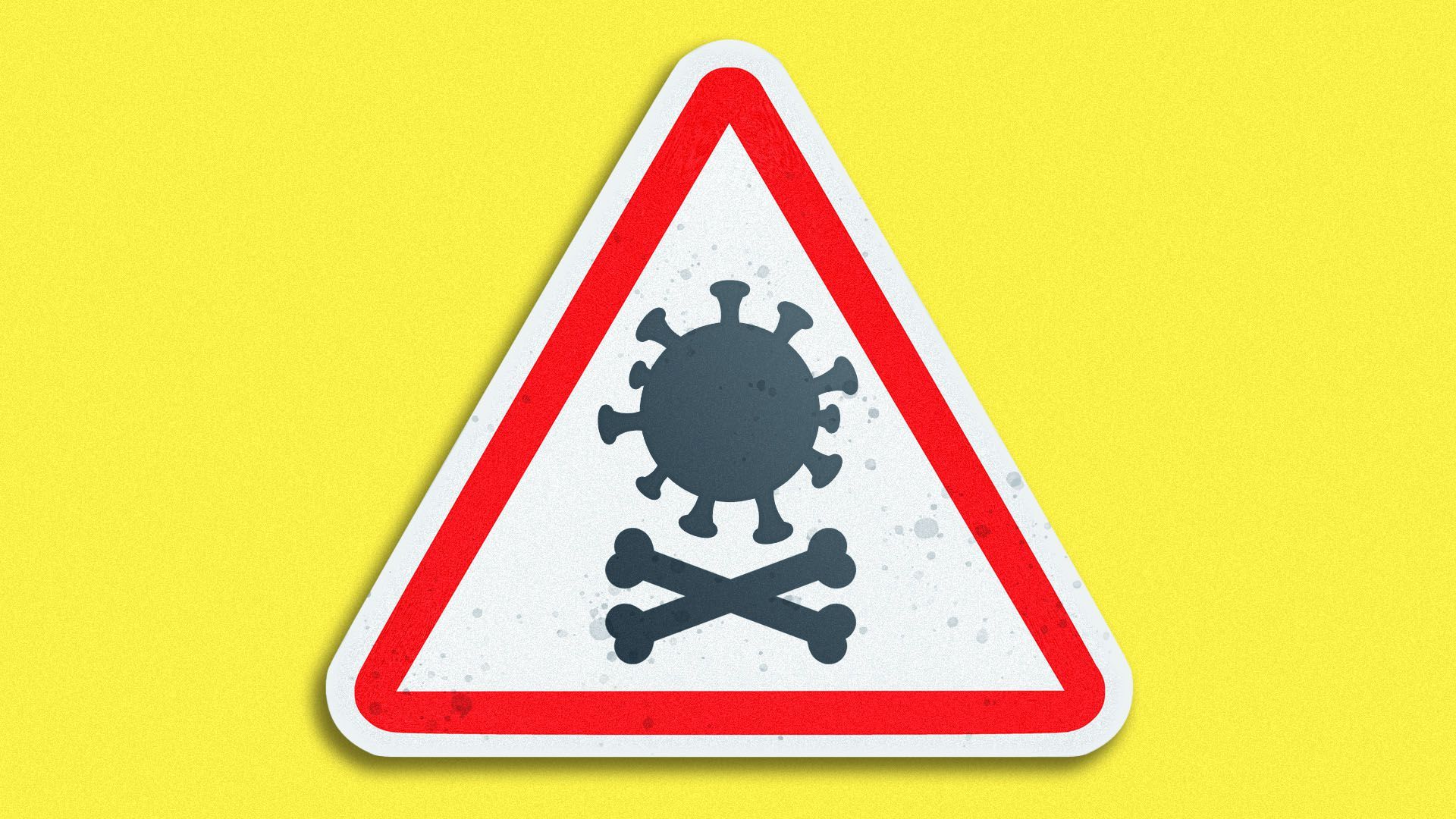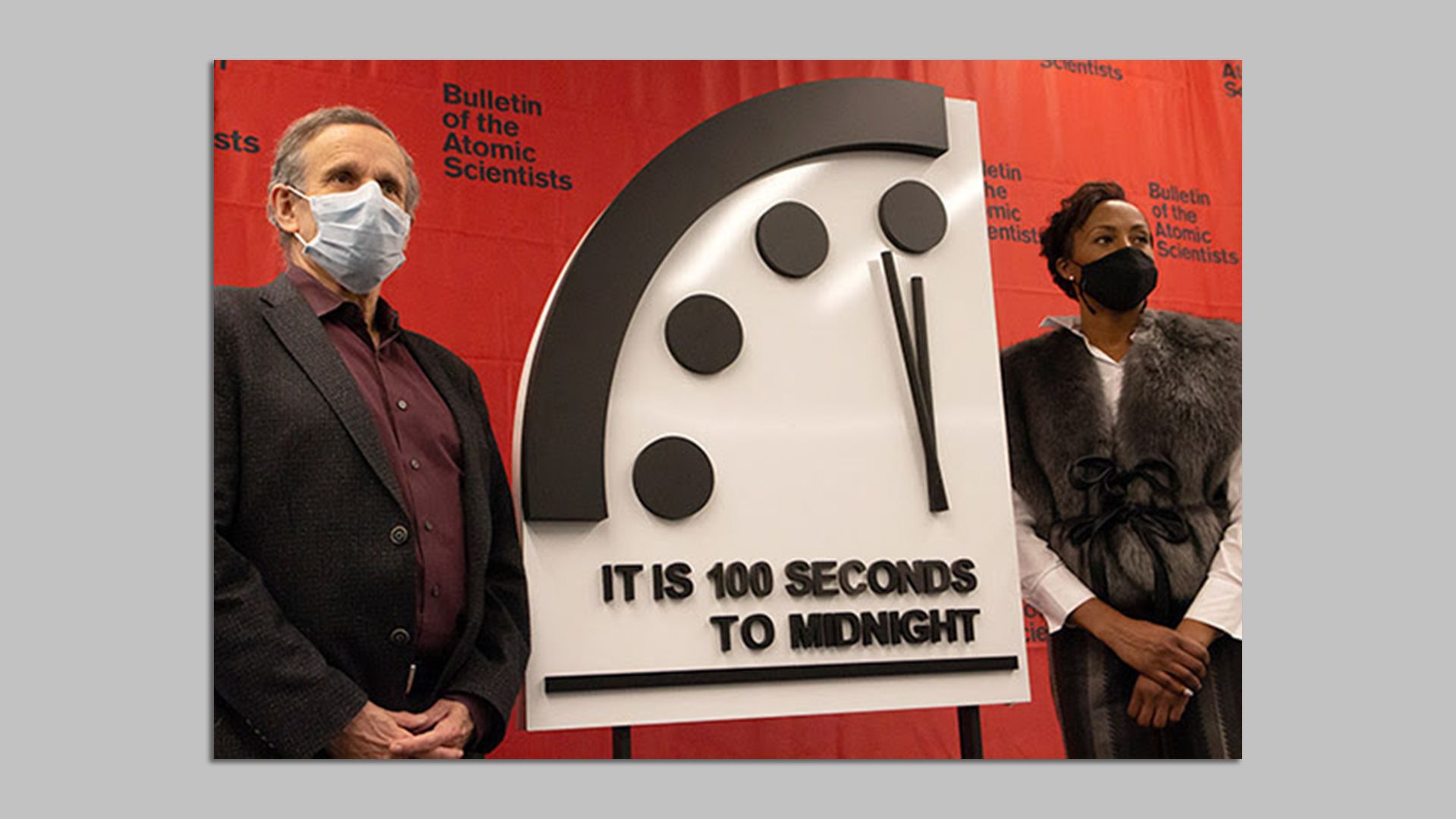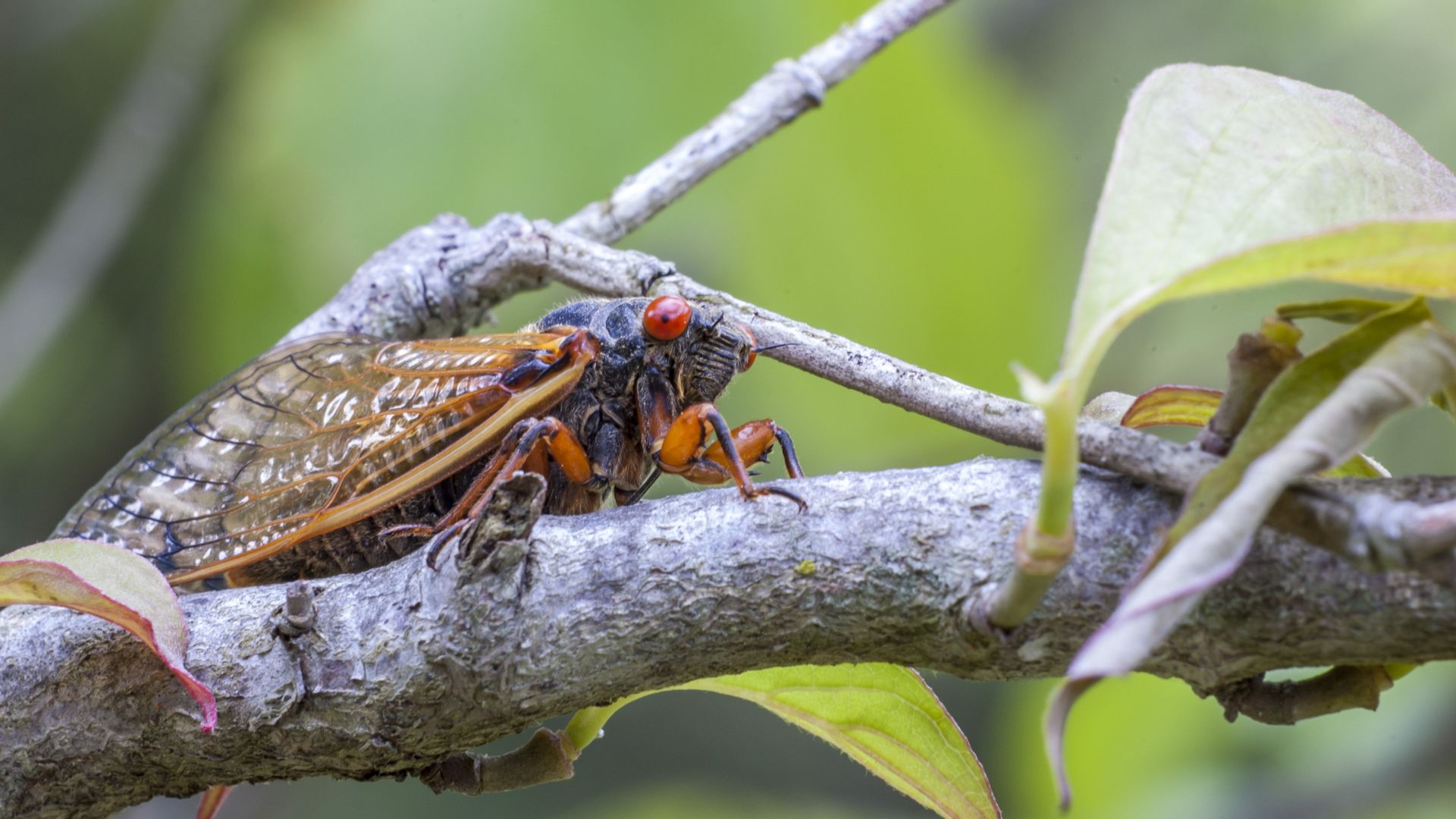| | | | | | | Presented By Babbel | | | | Axios Future | | By Bryan Walsh ·Jan 27, 2021 | | Welcome to Axios Future, which remains, as it almost always is, an entirely GameStop-free news zone. Today's Smart Brevity count: 1,877 words or about 7 minutes. | | | | | | 1 big thing: Coronavirus variants demand a tougher response |  | | | Illustration: Sarah Grillo/Axios | | | | New, more contagious coronavirus variants threaten the U.S. response to COVID-19 just as the best tools to fight it are becoming available. Why it matters: As our response to COVID-19 evolves and improves with the introduction of vaccines, so does SARS-CoV-2 itself, with new variants emerging. The next few months will demand harsher measures to control the pandemic at the very moment when exhaustion is peaking. Driving the news: On Monday evening, Minnesota reported the first confirmed case of the P.1 Brazilian variant of the novel coronavirus in a Twin Cities resident with a recent travel history to Brazil. - P.1 is one of four variants — mutated strains of SARS-CoV-2 that seem to spread more efficiently than the original coronavirus — the CDC is watching with concern.
- That includes the B.1.1.7 variant first identified in the U.K., which has now been detected in more than 20 states and which British scientists warn is both more contagious and potentially more deadly than the original strain.
- CDC officials project the U.K. variant could become dominant in the U.S. by March, which would drive more cases without a tougher response.
Details: The emergence of the new variants have driven governments to reimpose some border controls in an effort to stop their introduction, while scientists are pushing for more restrictions and hardier protective equipment. Context: At the same time, new COVID-19 cases and reported hospitalizations in the U.S. have fallen significantly in recent weeks, which in turn has led states like California to loosen restrictions on activity. - That's good news — as is the slightly increased pace in vaccinations — but average deaths per day this month are still above 3,000, and the overall COVID-19 risk level throughout the country is still far higher than it was in the fall.
- Recent research shows Americans as of late November were much less likely to observe social distancing than they were at the start of the pandemic, even though the risk — especially with the emerging variants — is likely even higher now.
Be smart: We can simultaneously be doing almost enough to control the spread of the original coronavirus strain and not enough to control more dangerous variants. - "There are essentially two separate COVID-19 epidemics," the National Institute for Public Health and the Environment in the Netherlands reported last week. "One epidemic involving the 'old' variant, in which infections are decreasing, and another epidemic involving the (new) variant, in which infections are increasing."
- The more the coronavirus spreads, the more opportunities variants will have to crowd out their competition — or for entirely new mutants to emerge.
Yes, but: All indications are that existing vaccines will remain effective against the known variants. - One possible exception is the South African variant 501Y.V2. Moderna reported this week that the antibodies triggered by its vaccines were less effective at neutralizing the variant, though the vaccine still provided significant protection and the company said it could develop a booster shot if needed.
The bottom line: Think of this next and most dangerous stage of the pandemic as a three-sided race: more contagious variants against the pace of vaccinations against our own willingness to endure more social distancing. - With the ranks of the immunized growing, it won't be a marathon, thankfully — but it won't be a sprint either.
|     | | | | | | 2. Doomsday Clock stays at 100 seconds to midnight |  | | | Robert Rosner, L, and Suzet McKinney reveal the 2021 setting of the Doomsday Clock. Photo: Bulletin of the Atomic Scientists/Thomas Gaulkin | | | | In its annual update on Wednesday morning, scientists announced the Doomsday Clock would be kept at 100 seconds to midnight. Why it matters: The decision to keep the clock hands steady — tied for the closest it has ever been to midnight in the clock's 74-year history — reflects a picture of progress on climate change and politics undercut by growing threats from infectious disease and disruptive technologies. Driving the news: In a virtual event, board members of the Bulletin of Atomic Scientists announced they would keep the Doomsday Clock at the same setting as 2020. - Rachel Bronson, the group's president and CEO, said "the world has entered into the realm of a 2-minute warning. The risk is high and the margin for error is low."
Details: If keeping the clock's hands unchanged lacks drama, the decision captures a year that saw some progress even as the world experienced the worst pandemic in a century. - As terrible as COVID-19 has been, Bronson noted accurately that SARS-CoV-2 "will not obliterate humanity," which is precisely the category of threat the clock was designed to highlight.
- The threat of climate change — which has risen as a concern for the clock's scientists in recent years — receded somewhat in 2020, with carbon emissions falling, thanks in large part to the pandemic, and the U.S. preparing to rejoin the Paris agreement under President Biden.
- While the threat of sudden nuclear war has risen in recent years, a new treaty to outlaw nuclear weapons and the likely renewal of the New Start arms control treaty by Russia and the U.S. offer some hope.
Yes, but: The reality is that the Doomsday Clock — which grew out of the work of researchers who had been involved in the Manhattan Project — may have outlived its usefulness in an age when existential risk has become so diffuse and fast-moving. - While the clock's hands remained unchanged this year, the truth is that existential risk is growing year by year, as destructive new technologies outpace our ability to control them.
The bottom line: In an age when nuclear weapons are just one of many ways humanity could bring about its own end, should midnight finally strike, it won't come with a countdown. |     | | | | | | 3. Detecting and defending against man-made pathogens |  | | | Illustration: Annelise Capossela/Axios | | | | A bipartisan commission is recommending an "Apollo Program" to enhance U.S. biodefense — including against engineered viruses. Why it matters: COVID-19, which will cost millions of lives and trillions of dollars, shuts the door on any argument that new diseases aren't a major global threat. But as biotechnology improves, we especially need ways to detect and deter pathogens designed by human beings, not just by nature. Driving the news: On Tuesday, the Bipartisan Commission on Biodefense released a set of recommendations outlining how the U.S. could end pandemic threats — both natural and man-made — by 2030. - The commission — which is co-chaired by former Sen. Joe Lieberman and former Homeland Security Secretary Tom Ridge — argues for spending up to $10 billion a year to speed up vaccine prototypes, enhance genomic sequencing capabilities, and create a national public health data system, among other recommendations.
Details: The report's conclusions are solid, and they're bolstered by the fact that the commission made much the same argument in 2015, years before COVID-19. But I was particularly interested to see the attention paid to the threat of man-made pathogens. - The report noted that "advances in biotechnology have also made it easier to obtain or modify these pathogens, creating the possibility of pandemics emerging from deliberate attacks or laboratory accidents."
- The commission focused on the need to develop techniques to "distinguish natural and engineered DNA and to inform attribution" of any new pathogens.
What's next: In a recent competition, hundreds of teams around the world developed algorithms designed to predict the origin of genetically engineered DNA sequences. - The best teams were able to predict the source lab of an unfamiliar engineered DNA sequence over 95% of the time, an improvement over the top previous results.
- Such algorithms can be useful for regulating genetic engineering by ensuring that any edited sequences can be tied back to their point of origin.
- But none of the algorithms would be able to determine for sure whether an unknown DNA sequence was natural or engineered, notes Lane Warmbrod, a senior analyst at the Johns Hopkins Center for Health Security.
The bottom line: We can't stumble blindly into a world where DNA can be engineered like computer code. |     | | | | | | A message from Babbel | | How to train your brain to learn a new language | | |  | | | | Babbel is helping people learn a new language with 15 minutes of daily practice. The result: Within three weeks, many of the app's users are conversational in their language of choice. Choose from 14 different languages, including Spanish and French, and get 50% off. | | | | | | 4. The rebellion against Silicon Valley |  | | | Photo illustration: Sarah Grillo/Axios. Smith Collection/Gado via Getty Images | | | | Silicon Valley may be a "state of mind," but it's also very much a real enclave in Northern California. Now, a growing faction of the tech industry is boycotting it, my Axios colleague Kia Kokalitcheva reports. Why it matters: The Bay Area is facing for the first time the prospect of losing its crown as the top destination for tech workers and startups — which could have an economic impact on the region and force it to reckon with its local issues. While the pandemic's arrival sent tech workers to toil from home just as the Bay Area's housing crisis and mounting quality of life problems bubbled over, some are taking the opportunity to move to cities that better suit their lifestyles. - As many as an estimated 89,000 households have left San Francisco.
- "The majority of people I've spoken with ... are doing it not because of COVID-19 directly but because of the resulting degradation of public safety," says venture capitalist and former San Francisco Mayor Mark Farrell.
Between the lines: Those who never wanted to live in San Francisco (or the greater Bay Area) are finally getting the permission not to. The debate is equally (and perhaps even more) a referendum on the state of California. The other side: "What I take issue with is our leaders — people of means — abandoning our community when it needs us most," Twilio CEO Jeff Lawson recently tweeted. "Reaping the benefits of Silicon Valley's talent, tech incubators, mentors, professional network, and culture until they no longer need it." Read the whole story |     | | | | | | 5. Worthy of your time | | This Chinese lab is aiming for big AI breakthroughs (Will Knight — Wired) - The Beijing Academy of Artificial Intelligence is helping China take the pole position on AI.
The climate crisis is worse than you can imagine. Here's what happens if you try (Elizabeth Weil — ProPublica) - I don't fully agree with the framing, but this in-depth story about how a climate scientist's despair split a family is definitely worthy of your time.
Undercounting of Covid-19 deaths is greatest in pro-Trump areas, analysis shows (Olivia Goldhill — STAT) - To those who keep insisting that COVID-19 deaths are being overcounted, evidence actually indicates the opposite is occurring, especially in certain parts of the country.
Three steps to fight online disinformation and extremism (Peter Singer — Defense One) - Winning the war on disinformation will require fixing the code of civil society.
|     | | | | | | 6. 1 noisy thing: The return of the cicada |  | | | Coming soon to a backyard near you. Photo: Education Images/Universal Images Group via Getty Images | | | | Trillions of cicadas that have been growing underground for nearly two decades will burst to the surface this spring throughout the eastern U.S. Why it matters: The cicadas of Brood X, which emerge like clockwork every 17 years, can be appreciated as a miracle of nature. Provided you can ignore the ear-splitting sound of their mating or the squish beneath your shoe when you inevitably step on one. How it works: 17 years ago, the periodic cicadas of Brood X were born, and as nymphs they burrowed underground, sucking fluids from the roots of plants as they grew. And grew. - When temperatures in the soil hit 64°F, the cicadas will crawl out of the ground all at once. It's a behavior that may provide them some protection from predators through sheer numbers — as many as 1.5 million cicadas can emerge in a single acre.
- Once they're out, they'll get to mating, and the sound of an entire field's worth of cicadas having cicada sex can exceed 100 decibels.
- Then they'll lay their eggs, die — and the 17-year circle of life begins again.
What they're saying: "This is a wonderful opportunity for millions of people to witness and enjoy a remarkable biological phenomenon in their own backyard that happens nowhere else on the planet, a truly teachable moment," Michael J. Raupp, an emeritus professor of entomology, told Newsweek. Reality check: Personally, I prefer my teachable moments quieter and less squishy. |     | | | | | | A message from Babbel | | The app that'll teach you a new language in less than a month | | |  | | | | With Babbel, you can become conversational in a new language with just three weeks of practice. The reason: The #1 sessions app teaches you the skills you need for real life scenarios, excluding any random words or unhelpful phrases. Get 50% off one of 14 languages. | | | | | | Axios thanks our partners for supporting our newsletters.
Sponsorship has no influence on editorial content. Axios, 3100 Clarendon Blvd, Suite 1300, Arlington VA 22201 | | | You received this email because you signed up for newsletters from Axios.
Change your preferences or unsubscribe here. | | | Was this email forwarded to you?
Sign up now to get Axios in your inbox. | | | | Follow Axios on social media:    | | | | | |









No comments:
Post a Comment